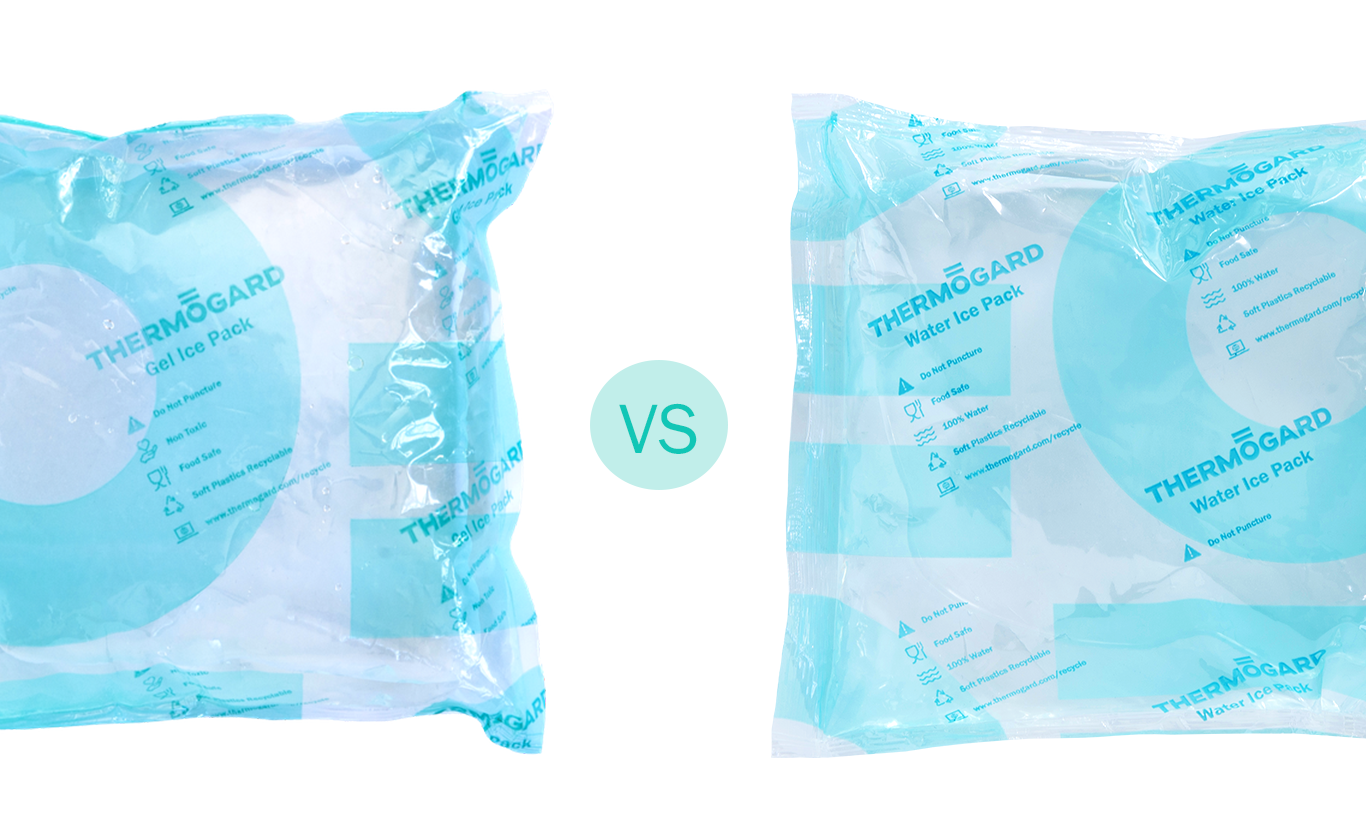Water Packs versus Gel Packs – How do they compare?

With options of both Water & Gel Ice Packs available, you may be asking yourself what the difference is between the two, and why you should choose one over the other? This is entirely dependent on your business needs and preferences. Although Gel Ice Packs were a development on the original Water Ice Packs, both still today have their applications, due to varying requirements of businesses in cool-chain transit.
Components
A Water Ice Pack is a sealed plastic pack that replicates the properties of ice, i.e., its cooling abilities, and consists of 100% water. As an improvement on simply using ice, a Water Ice Pack can be reused time and time again however can cause damage to product or packaging as it produces a lot of condensation when defrosting. Thermogard Water Ice Packs are encased in a high quality, soft plastics recyclable film.
A Gel Ice Pack consists of an absorbent that is mixed with water to form a gel, increasing the viscosity of the mixture. This in turn gives the gel ice a longer thaw time as the gel slows the conversion of energy of the water, ensuring your product stays cool during transit. Due to this additive, the condensation issue with Water Ice Packs is greatly reduced with Gel Ice Packs. Early Gel Ice Packs contained harmful ingredients like diethylene glycol or ethylene glycol, also known as antifreeze. However, as Gel Ice Packs have developed, and concerns of toxicity addressed, they now have non-toxic additives, like natural absorbent gels, as used in Thermogard Gel Ice Packs. Alike to the Water Ice Packs, Thermogard Gel Ice Packs are also encased in a high quality, soft plastics recyclable film.
Sustainability & Disposal
When it comes to sustainability and disposal, Water Packs can serve an advantage over Gel Ice Packs, as ultimately sustainability comes back to customer perception. With sustainability of a product closely tied to an understanding of the product & its components, Water Ice Packs can be seen as more environmentally friendly, due to public perception & a higher rate of correct disposal.
Water Ice Packs are often chosen due to their simplicity. Water is a familiar and natural ingredient and is known to be safe for both people and the environment. Due to the unknown characteristics of Gel Ice Packs, or the lack of understanding of their componentry, consumers can perceive these to be un-sustainable. Additionally, due to heightened awareness of the impact of packaging on the environment, Water Ice Packs are considered a sustainable choice by the public, as their effect or lack of on the wider environment is easily understood. Water Ice Packs can simply be cut open, have their contents poured down the drain, and the film can be soft plastics recycled.
With Thermogard Gel Ice Packs, this is not the case, as despite utilizing a natural based, drain safe gel, that when disposed of correctly Thermogard gel provides benefits to the environment rather than harming it, there is still uncertainty amongst the public. When there is a lack of education, assumptions can be made that Gel Ice Packs contain harmful ingredients and are therefore unsustainable. When disposing of Gel Ice Packs, a different process must be followed when pouring down the drain (see here), yet their film is recycled in the same way.
Consumers feel confident disposing of the contents of Water Ice Packs down their drain and know there is no implications to this. Whereas with Gel Ice Packs, due to their often ‘unknown’ additive’s, customers are unsure of what they are handling and how to dispose of it. This fear, paired with improper instruction or education from the supplier or business, can leave the consumer doubtful.
Performance
Gel based Ice Packs are the prominent coolant used in the transit of chilled or frozen goods, and for good reason. There are clear advantages to using Gel Ice Packs, as they were designed to improve thaw time of the pack, keeping your products cooler for longer. However, this does not mean that Water Ice Packs are not still a viable option.
Testing shows Gel Ice Packs will remain frozen for longer when compared to Water Ice Pack, although both variations of Ice Pack started out strong for the first three hours, remaining under three degrees Celsius, the Water Ice Pack began to thaw at a much quicker rate than the Gel Ice Pack. Based on our testing, our Gel Ice Packs have roughly 30% longer thermal performance than that of a Water Ice Pack.
If your product needs to be within strict temperature parameters or for a long transit time, you may want to opt for Gel Ice Packs as your coolant of choice. However, if your temperature parameters are more lenient, and your food may only travel a short distance, you can observe the Water Ice Packs will still provide cooling that preserves the quality of your product.
Testing Data comparing Water Ice Packs & Gel Ice Packs*

*We recommend you do your own thermal testing as your results may differ from ours. How your Gel Ice Pack/Water Ice Pack performs is highly dependent on your product, your transit time, your insulation and external ambient temperature.
Conclusion
In conclusion, the choice comes down to what factors are more important to you, as choosing Gel Ice Packs or Water Ice Packs as your coolants will be based on your preference and the unique requirements of your business. If any business is looking to move across from gel based to water-based ice packs, we recommend testing is completed to ensure your product is shipped safely and arrives at the correct temperature. If you have any queries about which coolant is the right fit for you, get in touch today.
Check out our Water Ice Pack Flyer below!
